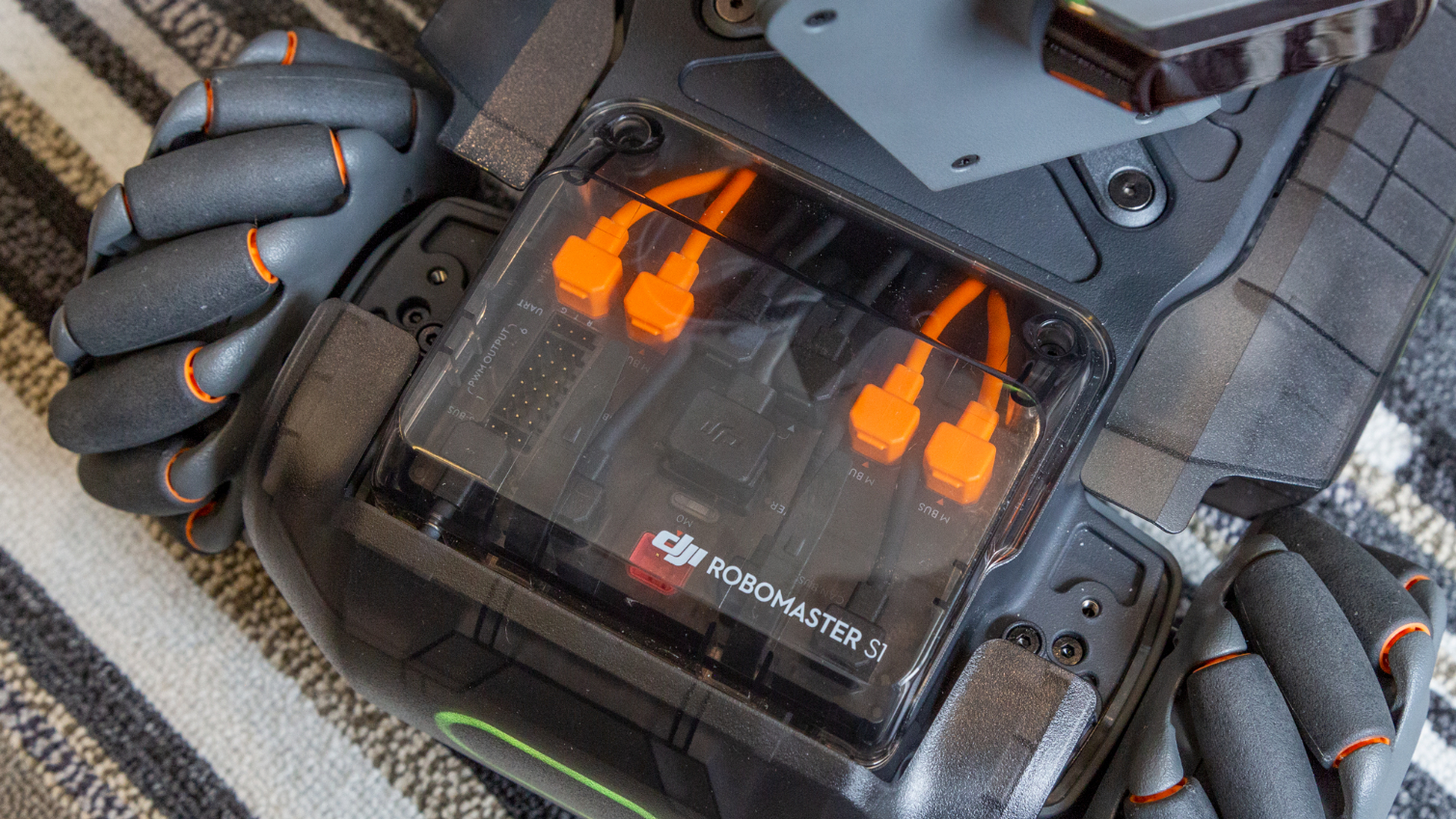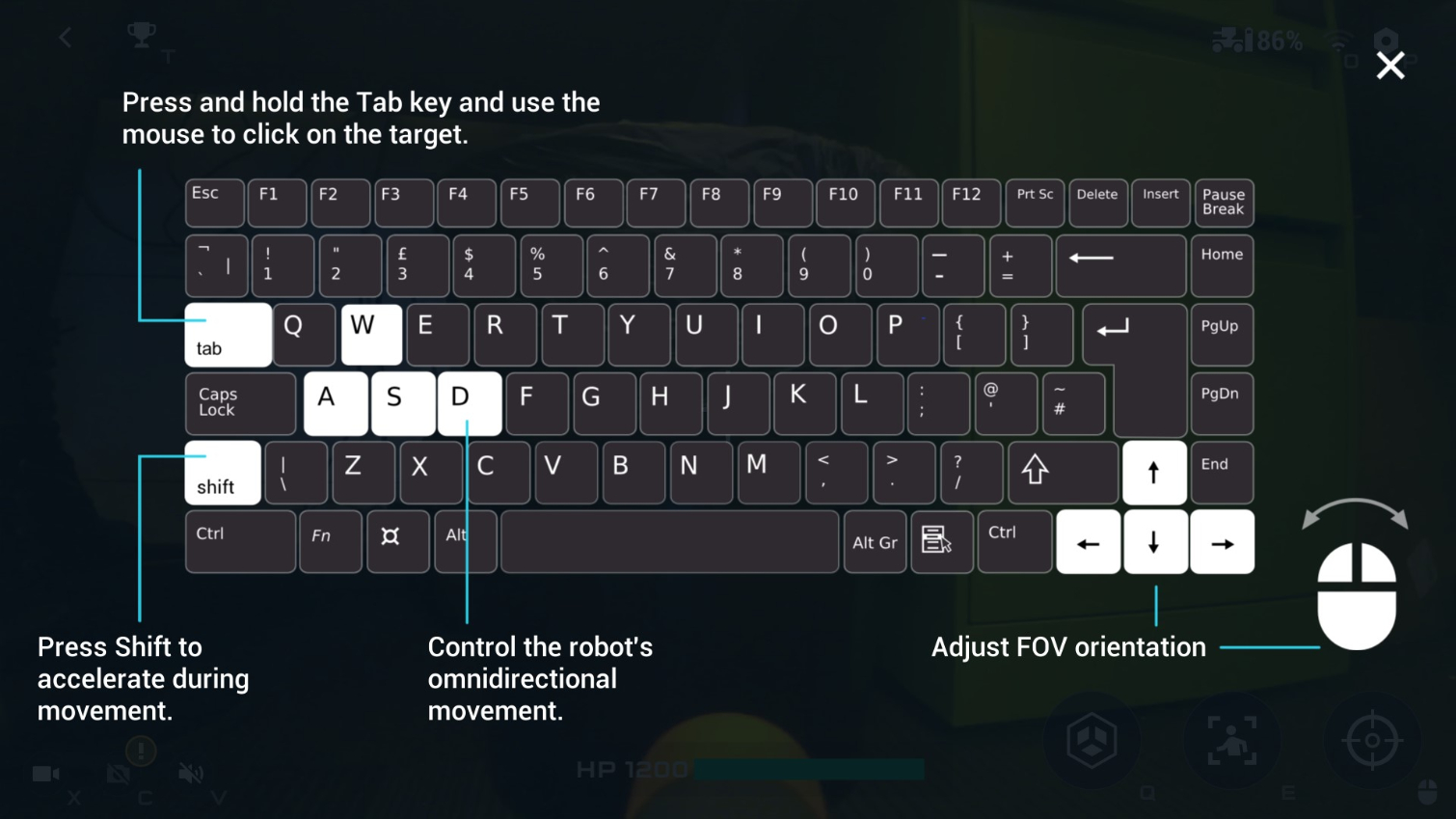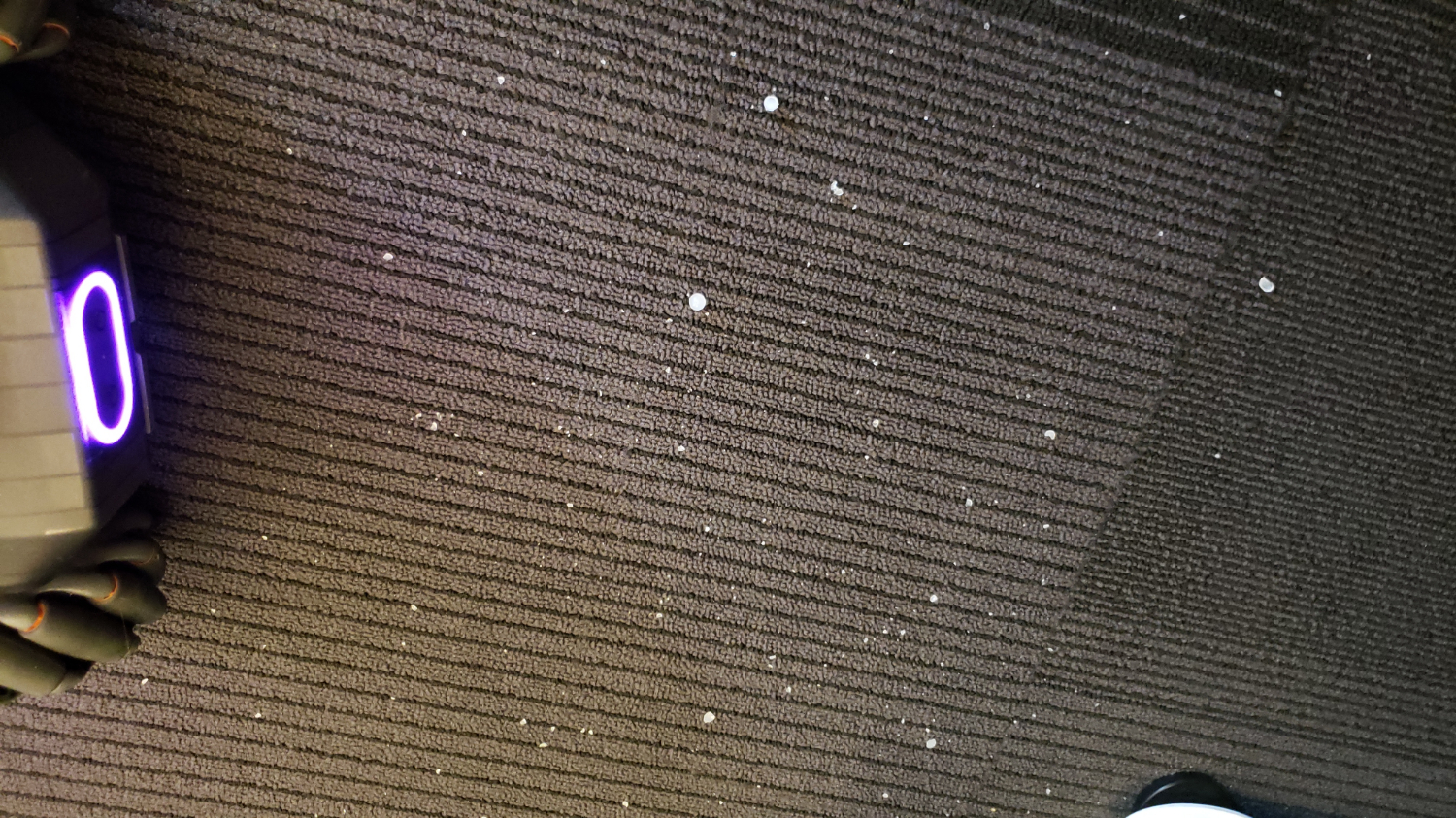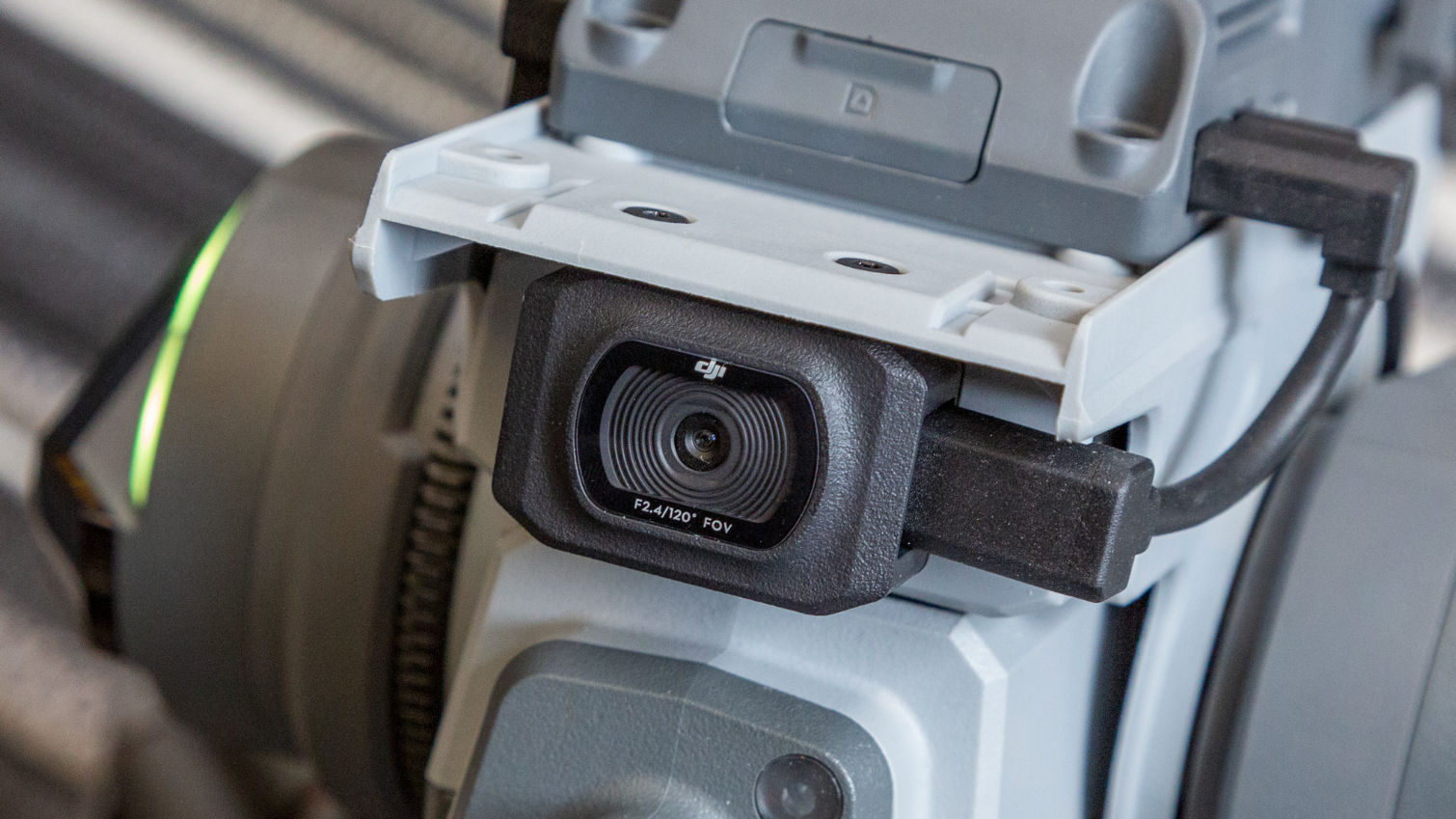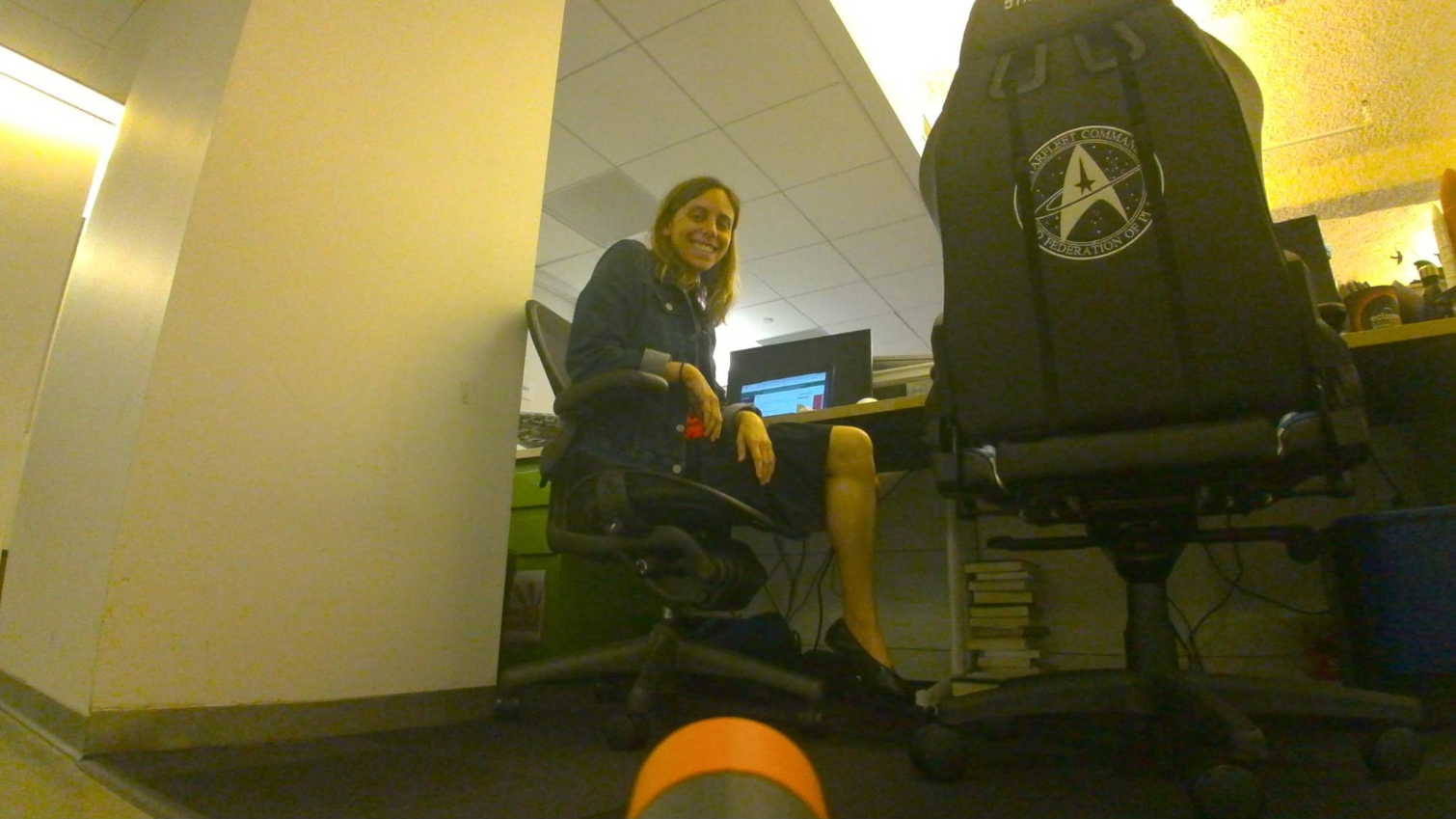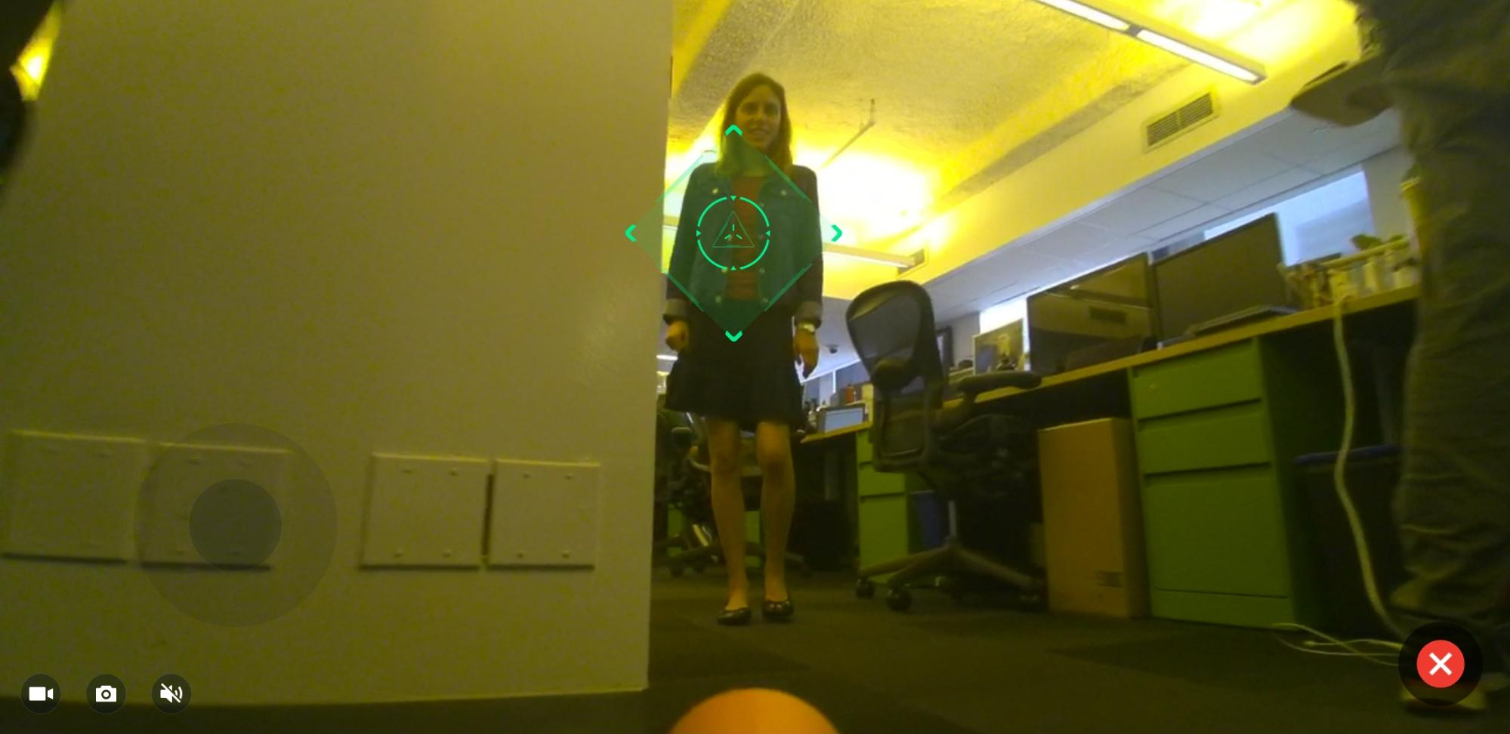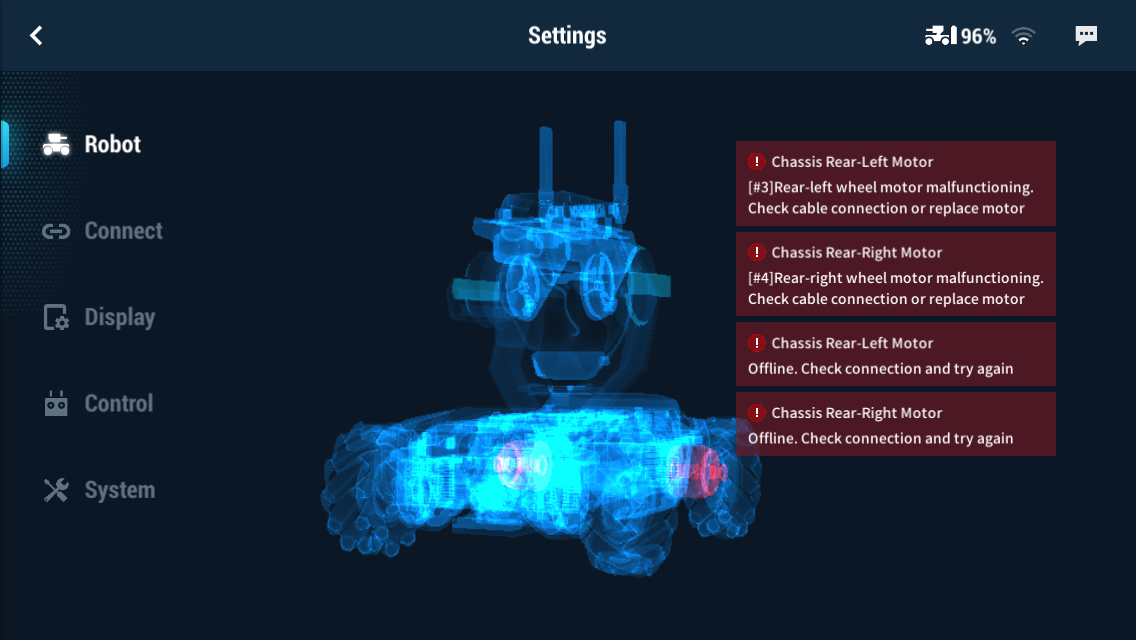Tom's Hardware Verdict
DJI RoboMaster S1 is one of the most premium, high-end STEM robots we’ve seen. But to max its potential and make it worth the price, younger kids will need adult assistance.
Pros
- +
Build it yourself
- +
Mesmerizing design
- +
Controllable RGB lights
- +
Programmable via Scratch block coding and Python
- +
Omnidirectional movement
- +
Extremely customizable
Cons
- -
Not great for mastering Python
- -
Coding lessons could be more exciting for kids
- -
Gel beads require hours of soaking before use
- -
Unclogging gel beads requires partial disassembly
- -
Expensive
Why you can trust Tom's Hardware
Built like a tank but with far more mobility and 21 LED lights, DJI went all in with its first robot, the DJI RoboMaster S1. It’s a battle STEM robot you build and program with Scratch block coding or Python.
Operated with a smartphone, PC or controller (sold separately) connected via Wi-Fi, the RoboMaster S1 packs premium features including 36 sensors, a 1080p resolution camera with object recognition and blaster for firing infrared beams or gel beads.
But premium features mean a premium $499 price tag. While an educational toy for all ages (with adult supervision for those under 14), younger kids will need help to prevent it from becoming a glorified remote control car.
DJI RoboMaster S1 Specs
| Companion App Compatibility | Android 5.0, iOS 10.0 and Windows 7 and later |
| Connectivity | Wi-Fi 802.11a/b/g/n: up to 5.8 GHz from 130m; Router: Up to 5.8 GHz from 300m |
| Field of View | 120 degrees |
| Battery | 2400mAh LiPo 3S; Controller: 2600mAH |
| Camera | 5MP, CMOS 1/4-inch sensor |
| Audio | Mic; 2W speaker |
| Storage | Supports microSD cards up to 64GB |
| Weight (with battery) | 7.6 pounds (3.5kg) |
| Measurements (LxWxH) | 12.6 x 9.4 x 10.6 inches (320×240×270mm) |
| Price | $499 |
Built Like a Tank (by You)
RoboMaster S1 starts off as a DIY project. Our review unit came pre-assembled, but DJI told us it expects the average user to take two to four hours to build it, “depending on the user’s experience.” I did do a little disassembly and assembly for troubleshooting. The instructions were sufficient, and I had plenty of fun pretending to be a robot mechanic.
It comes in 23 pieces, plus a screwdriver to assemble and 101 screws (6 different types). The included print-out instructions clearly label each individual part and the tools. However, most steps don’t have words, only pictures. Although, there is a 12-minute online video with narration. The robot isn’t recommended for children under 14 without adult supervision, and with the complexity of its design, younger builders will probably need assistance.
Once assembled, RoboMaster S1 is a solid machine with more weight (7.3 pounds) and ruggedness than similar, less expensive robots. It’s a sight to behold with tough plastic and humongous Mecanum wheels, the same style used for industrial containers and forklifts. The wheels boast 12 rollers each, allowing movement in all four directions. It employs an M3508I brushless motor and ESC with linear hall effect sensors and algorithms for better control.
For real-time hit point tracking on the companion app, sensors cover the robot’s plastic armor and detect when it’s struck by another RoboMaster S1.
Get Tom's Hardware's best news and in-depth reviews, straight to your inbox.
There’s a good burst of color too. The orange-accented blaster, wheels and cables are enough to make me feel young. But it’s the blaster’s ability to shoot gel beads or flashing lights (infrared beams) that really made us feel like a kid with a new toy. (More on that in the Battling section below).
Then there are the 21 LED lights (primarily in six areas) that can make one of 11 colors via the companion app for iOS, Android or Windows. That’s in addition to the gimbal and chassis LED indicators that flash different colors for different status updates.
The gimbal up top holds the “Intelligent Controller,” where the CPU lives, plus the blaster and camera. It moves along two axes at 540 degrees per second with a yaw (pan, left to right around the vertical axis) of 540 degrees and pitch (tilt up and down) of -20 to 35 degrees. You can turn its gyroscope on or off and control its sensitivity in the app.

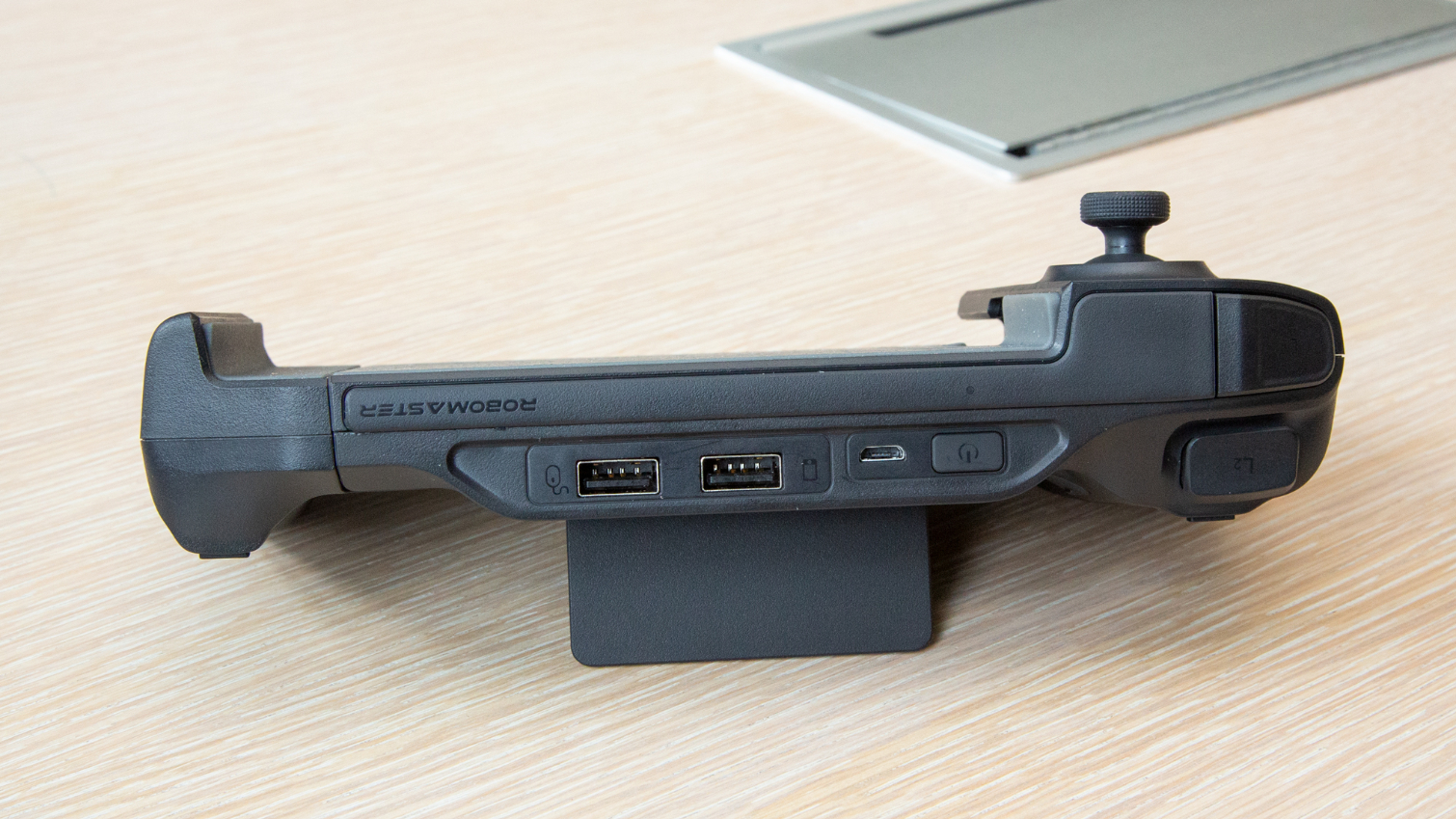
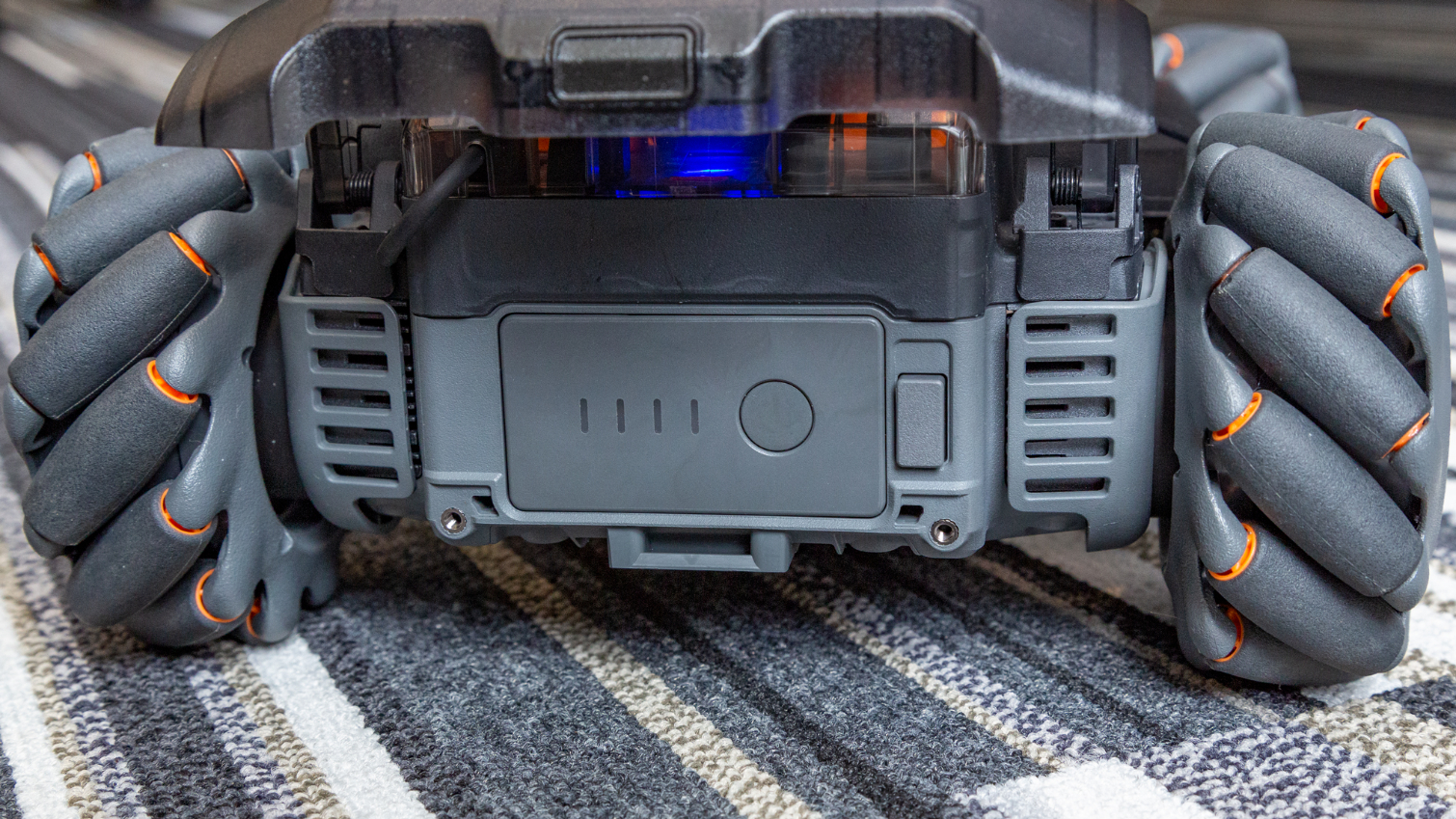
Pillaring the Intelligent Controller are two antennas, which click while bending accordion-style. They go all the way backwards, but optimal reception happens at 90 degrees. There’s also a switch for toggling between connecting to a smartphone or Wi-Fi Router (required for multiplayer) and some unoccupied ports: USB Type-C, Micro USB, CAN bus and microSD card reader.
The motion controller lives at the base under a transparent cover and commands all chassis movement with an omnidirectional wheel motion control algorithm and management systems for the chassis, motor and power. A small LED light is blue or yellow, green, red or white if there are motion-related issues.
The motion controller’s top row holds CAN and M bus ports for connecting the armor modules, power, motor and gimbal. You also get six PWM ports for attaching programmable third-party add-ons, like LEDs, accelerometers, another camera, servers and drivers. Surrounding those are an SBus port and UART port. Already we can see the RoboMaster S1 is designed to enable high-level customization and programming.
The S1 looks tough, but water is its weakness. It isn’t waterproof but works fine on hard outdoor surfaces like concrete, but is not recommended for dirt or mud.
And if speech is enabled, your RoboMaster S1 will talk occasionally, usually when setting up a router, game or calibrating, in a serious manly voice.
The Wheels Steal the Show
The wheels don’t just look cool; they’re mesmerizing in action. Passersby will do a double take when they see the rollers on the wheels spinning forward while the RoboMaster S1 slides side to side or in a circle. Controlling that phenomenon is even more addictive.
With wheels like this, this STEM toy’s got great precision and surprising speed. Even at its medium speed setting, colleagues in my office were impressed by how quickly it ran laps around the carpeted floor.
Spinning at up to 1,000-rpm per minute, the Mecanum wheels offer fantastic control, moving in all four directions gracefully. That means no stuttering or tipping over during quick turns and transitioning from carpet to tile without stumbling.
With overvoltage, temperature and short-circuit protection, the wheels are built for the long haul. It’s not silent when moving, but the noise it makes, like playing cards shuffling in a machine, is pleasant compared to the buzzing mechanical sounds of many remote control cars.
Controlling the RoboMaster S1
You can see everything the RoboMaster S1 sees on your smartphone or PC. The image quality is pretty consistent, albeit washed out, displaying at 720p resolution at 30 frames per second (fps).

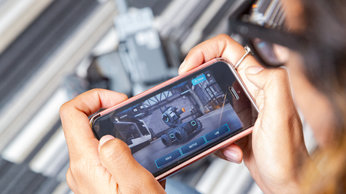
There are a few different ways to control the RoboMaster. The easiest way is to use your smartphone, which offers reliable control.
You can also connect to the DJI bot with a Windows PC (via keyboard and wired/wireless mouse or touchpad) or the gamepad (sold separately). You have to connect a smartphone or mouse to the gamepad to use it.
RoboMaster Gamepad
The RoboMaster gamepad also has a kickstand for placing it upright.
Starting in July, you can get the gamepad by buying DJI’s “PlayMore Kit,” which also includes an extra battery, gel beads and gel bead container (price TBD). It’s the most fun way to control the RoboMaster, even though the controller’s a little chunky. To use it, attach your smartphone via the USB-A port. The clamp and rubber make for a snug, slide-free fit.
The downside is that while the joystick moves the RoboMaster S1 forward, backward, left and right, you still have to hit your smartphone’s touchscreen to rotate. For the extra money, we’d rather all controls be on the controller, and, frankly, to not need a smartphone too.
The “L” button on the upper left corner launches coded skills, there are L1 and L2 buttons for cooling down and firing the blaster, respectively, and a button around back for using power-ups acquired in game modes via paper markers.
You can also connect a wired/wireless mouse (via USB Type-A dongle) to the gamepad. The experience is best with the gamepad propped up with its kickstand. But this is counterproductive because it takes away the mobility the gamepad enables, what makes it exciting in the first place, and also replaces the firing button on the gamepad with the mouse’s left click.
The gamepad uses a 2600mAH battery that DJI says has a battery life of about 2 hours and charges in about the same amount of time. In my usage, the gamepad never died before the robot. It charges via an included micro USB cable, updates with its own firmware and has an LED light that changes based on the controller’s remaining battery life.
RoboMaster on Windows
If the gamepad is the most fun way to control the RoboMaster S1, the PC is the most productive. With the free app for Windows 7 and later, you can bring the RoboMaster S1’s viewpoint to the big screen (or whatever size your monitor or laptop display is). In this mode, you control RoboMaster S1 with the W, A, S and D keys and rotate it with your mouse. It took a moment to get used to its sensitivity to the mouse, but ultimately a larger screen livened up the action, making me feel like a hacker in a spy mission.
Robot Fights
The RoboMaster S1’s orange-tipped blaster reminds me of Nerf guns, which automatically made want to load up and start attacking people -- I mean, robots. But equipping the blaster with its gel beads isn’t as effortless as loading a Nerf gun. And somehow the end result is messier.
With the RoboMaster S1 you have two options, pegging foes with gel beads or pestering their senses with an infrared beam, a green light the blaster projects.
The beads would be the obvious choice if it weren’t for how difficult they are. Before usage, you’re required to soak them for 3-4 hours. They’ll expand until they’re the size and consistency of caviar. But after soaking mine for about four hours the firing range and power was pitiful. The robot spit out pieces of the balls with minimal force, and most of the time it shot nothing at all.
To prepare for my next battle, I soaked the beads for 6 hours, but they still weren’t giving me the firing power or consistency I wanted. After partially disassembling the robot to access the clear out the blaster’s queue, I finally got the firepower I needed.
The beads came out with sufficient force, sometimes as whole pieces, other times with fragments bursting out too but with stiff enough power to properly aim, strike and make my metal trash can sing.
You can have up to a 6-robot match and set your own time limit. Battling is great, with a hit point tracker and the ability to do damage by smashing into each other or attacking with your ammo of choice. Included paper markers can be erected to serve as power-ups. Using object recognition to scan, you can find health, make all robots within 3 meters suffer screen interference for 2.5 seconds, makes opponents spin uncontrollably for 1.5 seconds or get temporary super speed or invincibility. When I battled sister site Tom’s Guide’s RoboMaster S1, I didn’t encounter any glitches, just a confidence-crushing defeat.
Is It Safe?
A lot of things this fun aren’t safe. DJI says this isn’t the case with RoboMaster, although it does advise kids under 14 seek adult supervision.
The gel beads are non-toxic, and although the packaging and app warn against blasting beads around small children or pets, DJI told me that should such a creature somehow ingest a bead or its particles they’ll be fine. Plus, according to DJI, the beads are bitter, so they shouldn’t want seconds. The robot also comes with a pair of safety goggles.
I fired a few beads at myself, and the feeling was jolting, but not painful. It hurt far less than getting hit by a BB gun.
There are also limitations in place. The beads fire at a 26 meters per second (mps) at up to 10 rounds a second. Thanks to the blaster’s speedometer, a bead won’t launch if its previous speed was higher than 26 m/s, and they can only fire at a 10-degree or smaller angle. And don’t bother loading it with something more diabolical; the speed will be automatically shuttered so it can’t hurt anyone, DJI told us.
But while the beads are “safe,” they’re also messy. Since the beads expand while soaking, if your container isn’t big enough they’ll eventually overflow and bounce all over the place (boy are they bouncy). And with the loading hole being about the size of a U.S. gold dollar, it’s easy to drop some on the ground. The beads disintegrate after shooting but still leave white specks on the ground. You’ll want to vacuum after firing a few rounds. After a week of firing and accidentally dropping gel beads around the office, I hope the cleaning crew never finds out who I am.
Other Games
If you own a RoboMaster S1 and don’t know someone else who has one, there are some solo modes you can enjoy. There’s always the fun of simply driving around and shooting beads or infrared beams about (cautiously, of course). But the app also comes with a couple of single-player games.
In “Target Practice,” you’re tasked with setting up the included paper markers (numbered 1-5) and infrared beaming the right ones when prompted in a limited time frame. It gets harder with each level.
For “Target Race,” you set up the markers then drive around to scan each marker in a particular order. You can even code the robot to follow a certain color and create a track that it will continuously loop while you control its gimbal and shoot as necessary.
You certainly don’t need two RoboMaster S1s around to enjoy the robot. But we wouldn’t mind seeing some more single-player games, since the likelihood of another person (especially a child) scoring a $500 toy robot is relatively slim. A well-functioning augmented reality (AR) game, like the one found in the GJS’ Geio Robot, comes to mind.
Coding the RoboMaster S1
Many STEM robots are programmable in some form, but the possibilities with the RoboMaster S1 are both greater and more advanced. Then there are the PWM ports, which can vary output to third-party add-ons, like LED lights and navigation gears. This is way more advanced than what you’d get with more-affordable STEM bots.
Using Scratch block or Python, you can program the robot’s response to certain hand gestures, the number of claps it hears, seeing another RoboMaster S1 or even to follow a certain color line (great for making racetracks). But if you’re looking to become fluent in Python, you’ll need another instructor.
You can copy Python code from the online programming guide, but it’s hard to truly learn Python with this toy, regardless of age. Some Python programs don’t have any instructions or have complex ones that aren’t kid-friendly, like “(1) Objective: Obtains information for identified lines in terms of the parameters N, Info, X, Y, θ, and C,” or this note included in the gesture recognition instructions “The first item is the number of gestures the robot has identified. The second item is a group of 5 numbers: gesture ID, X-axis of the center point, Y-axis of the center point, W-width and H-height.”
All coding occurs within the companion app, where you can also backup your programs in the cloud. The app has three different coding sections.
Road to Mastery has nine project-based Scratch tutorials. We appreciate that the app tracks your progress, and a sidebar shows your percentage of completion for three skills: programming, control and AI. This motivates you to keep learning with the RoboMaster S1. Less encouraging, there’s no way to tell which missions you’ve completed already from the home page.
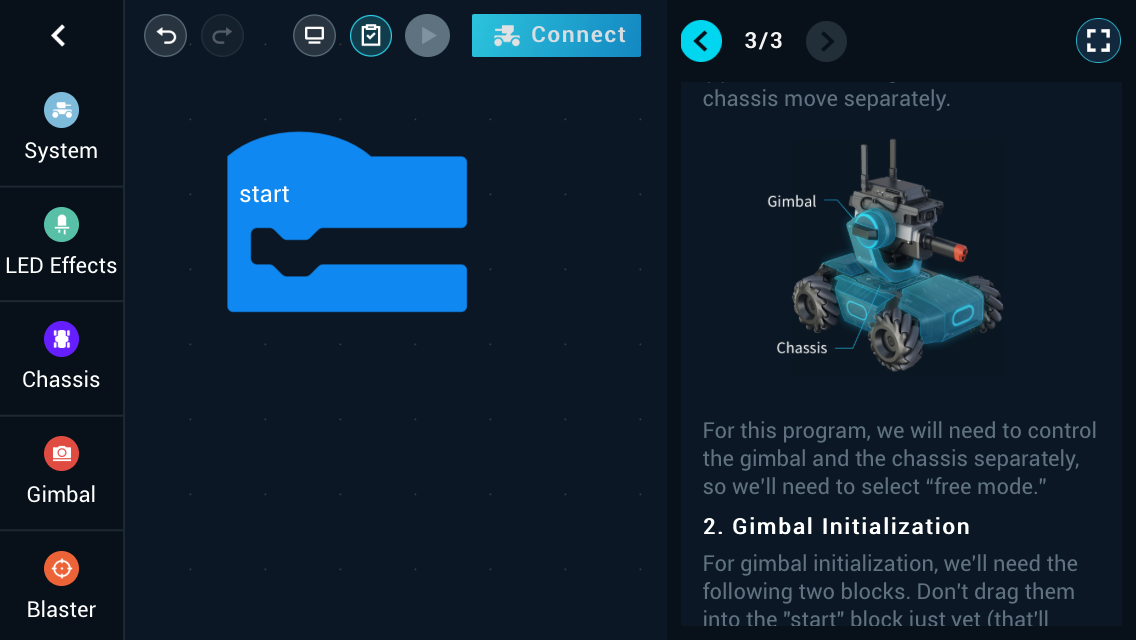

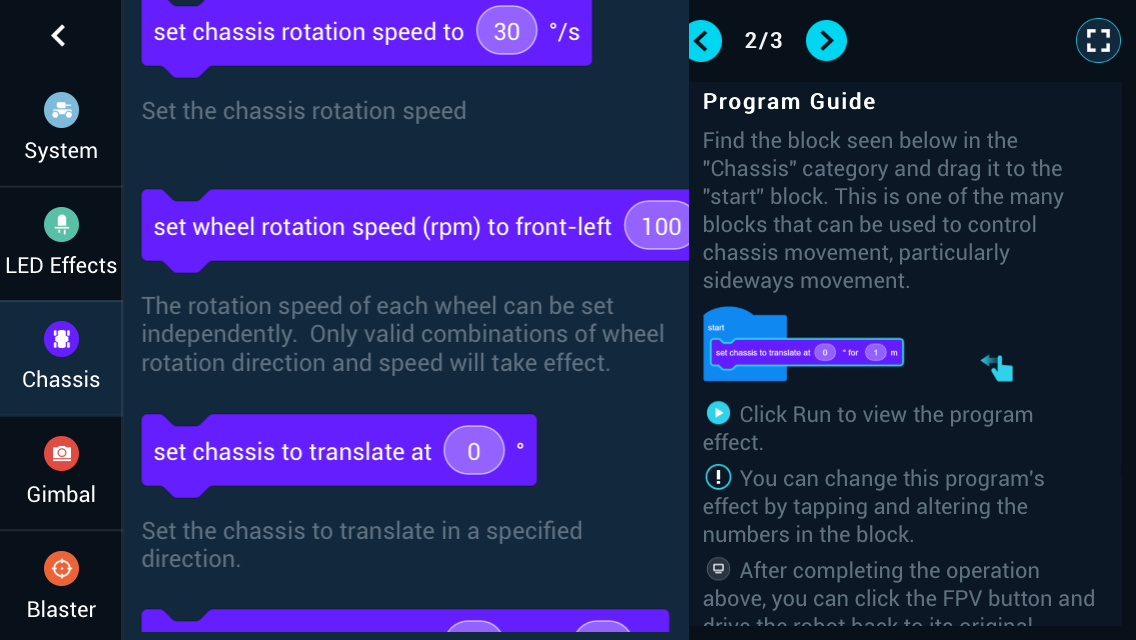
Thanks to clear instructions, kids should be able to complete each block-coding tutorial on their own. They have very detailed and helpful directions with animations and explanations of relevant hardware (like how Mecanum wheels work) and what advantage the program will provide on the battlefield. Just make sure you’re coding with ample screen space.
Helpful for new coders, Road to Mastery has a debugging function that highlights errors in your code, like using the wrong type of block. Qhen you finish a level, you’re rewarded with a congratulations and an update on your completion rate. What the mode lacks is a way to copy and paste blocks. Often I found myself having to scroll for a block I literally just used.
RoboAcademy, another coding section of the RoboMaster app, has shortcuts to DJI’s online programming guide, with dozens of Scratch and Python programs you can copy into the app, and programming video tutorials.
Finally, the app’s DIY Programming sections lets you turn your Scratch or Python code into usable moves on the battlefield to make your robot more formidable in single-player or two-player modes. If improving your ability to slaughter other robots doesn’t motivate a kid to code, I don’t know what will.
Camera and Object, Color and Facial Recognition
The RoboMaster S1 can capture its favorite moments in up to 2560 x 1440 resolution photos or 1080p video at 30 fps with a MicroSD card (up to 64GB, not included). It uses a 5MP camera with a CMOS 1/4-sensor, so don’t expect smartphone-level quality.
The camera employs anti-flickering technology, which you can set to 50 or 60 Hz in the app, which warns that indoor lighting frequency can “cause issues” (I didn’t encounter any).
The camera is also used for programs you code using artificial intelligence (AI), like the aforementioned clap, gesture and color recognition. Even without coding, the RoboMaster S1 uses object recognition for games that use paper markers. It executes this form of AI effortlessly. I was never robbed of a win because I couldn’t scan something properly.
Facial recognition allows for a cool feature, Follow Me, where the RoboMaster S1 can lock onto a person and follow them around (like a pet!). I struggled to get my robot to lock onto me, but it did lock onto others if they were in bright lighting. It had no trouble stalking its target, as long as it didn’t run into physical interference.
RoboMaster App
Compatible with Android and iOS devices and Windows PCs, the RoboMaster app not only lets you control and play games with the RoboMaster S1, but also offers hardware support.
The app offers customization options like choosing a color for the LED lights and HP bar, setting speed, adding a gimbal angle readout to your app’s display and selecting how you control it (smartphone, keyboard/mouse etc.).
You can also fine-tune your robot with Armor Addressing, Motor Addressing and Gimbal and Chassis Calibration. Through the app, you can run tests that take just a few minutes to make sure everything is in working order.
With a robot this complex (and pricey) technical issues would be devastating. But the app helps you through such issues by highlighting problem areas and encourages calibration. It successfully alerted me when my RoboMaster S1 started having issues; however, I had already noticed the previous afternoon when it was driving backwards.
If you do encounter any issues, the app’s surprisingly soothing background music may help you through.
Battery Life
The RoboMaster S1’s battery has green lights that tells you its charge status and if something’s wrong. The battery takes 90 minutes to fully charge and has temperature, overcharge, overcurrent, over discharge and short circuit protection and sleep mode.
During my time with the robot, it lasted on average 1 hour and 30 minutes with regular usage and up to 2:30 with on and off play. DJI estimates the battery will survive for 35 minutes if you’re driving the robot non-stop.
Heat
After about 1 hour and 2 minutes of heavy usage, including coding with all the lights on and sound off, I could feel some warmth around the sides of the gimbal and back.
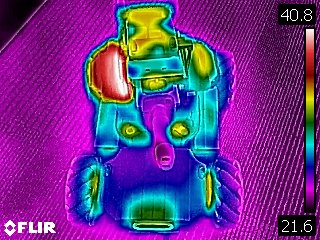


After playing with the RoboMaster S1 for 15 minutes, with LED lights and sounds on, making it follow me around and shoot things, the hottest point was the right side of the gimbal at 40.8 degrees Celsius (105.4 degrees Fahrenheit), and you can see the Intelligent Controller on top, where the CPU is warmed up.
Bottom Line
DJI’s RoboMaster S1 is a one-of-a-kind robot that a kid’s sure to remember. But let’s be real: this is an expensive toy. At $500 it'll set you back more than a PlayStation 4 or Xbox One, and your kid’s likely to play with the consoles more.
But for a STEM robot, the RoboMaster S1 is as good as it gets. Its Scratch block coding tutorials are on par with that of other robots, plus you get unparalleled customization options with PWM ports for add-on programmable hardware. You build it yourself, driving it is a blast and it actually shoots things, although we wish it had more single-player games. But kids (and adults) new to coding will only be able to master Scratch, not Python. And without a gaming angle, we worry kids will lose interest, even in block coding.
DJI recommends children under 14 only use the RoboMaster S1 with adult supervision. We’d add that they’ll also need your help to maximize the fun and use it to its full potential. For older robot fans who have been waiting for a mature, premium STEM toy, this is it.
Photo Credits: Tom's Hardware, DJI
MORE: All Robot Content

Scharon Harding has over a decade of experience reporting on technology with a special affinity for gaming peripherals (especially monitors), laptops, and virtual reality. Previously, she covered business technology, including hardware, software, cyber security, cloud, and other IT happenings, at Channelnomics, with bylines at CRN UK.


